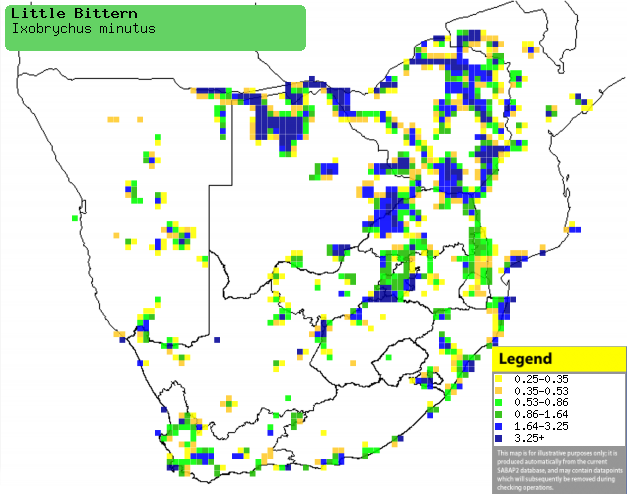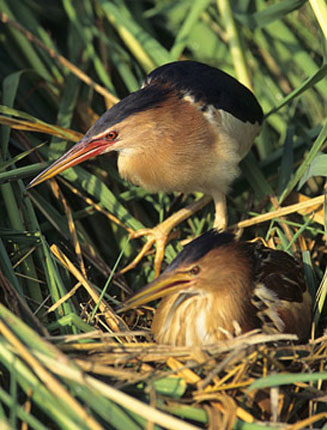|
Ixobrychus minutus (Little
bittern)
Kleinrietreier [Afrikaans]; Woudapie [Afrikaans]; Ihashe
[Xhosa]; Mwene-mwene hakaruu [Kwangali]; Khoitinyane [South Sotho];
Woudaapje [Dutch]; Blongios nain [French]; Zwergrohrdommel [German];
Garçote-comum [Portuguese]
Life
> Eukaryotes >
Opisthokonta
> Metazoa (animals) >
Bilateria >
Deuterostomia > Chordata >
Craniata > Vertebrata (vertebrates) > Gnathostomata (jawed
vertebrates) > Teleostomi (teleost fish) > Osteichthyes (bony fish) > Class:
Sarcopterygii (lobe-finned
fish) > Stegocephalia (terrestrial
vertebrates) > Tetrapoda
(four-legged vertebrates) > Reptiliomorpha > Amniota >
Reptilia (reptiles) >
Romeriida > Diapsida > Archosauromorpha > Archosauria >
Dinosauria
(dinosaurs) > Saurischia > Theropoda (bipedal predatory dinosaurs) >
Coelurosauria > Maniraptora > Aves
(birds) > Order: Ciconiiformes
> Family: Ardeidae
Distribution and habitat
It has two subspecies: one resident in Africa and the
other breeding from Europe to China and the Mediterranean, heading south
in the non-breeding season to India and sub-Saharan Africa. Here it is generally uncommon in Namibia,
northern and south-eastern Botswana, Zimbabwe, central and southern Mozambique
and isolated patches of South Africa. It generally prefers Bulrushes (Typha
capensis) and reeds (Phragmites) in water, such as in vleis or along
the edge of wooded watercourses or sewage ponds.
|
 |
|
Distribution of Little bittern in southern Africa,
based on statistical smoothing of the records from first SA Bird Atlas
Project (©
Animal Demography unit, University of
Cape Town; smoothing by Birgit Erni and Francesca Little). Colours range
from dark blue (most common) through to yellow (least common).
See here for the latest distribution
from the SABAP2. |
Movements and migrations
Movement patterns vary greatly between the two
different subspecies: L. m. payesii is largely resident
while L. m. minutus is a palearctic breeding migrant, present
in southern Africa in the period from December-April.
Food
Its diet is not well known, but is thought to mainly
consist of frogs, lizards, fish and invertebrates, doing most of its foraging by
creeping through cover in search of prey. It catches animals by rapidly
thrusting its bill forward, spearing the prey while slightly extending its
wings. The following food items have been recorded in its diet:
- Vertebrates
- fish
- Cyprinus carpio (Carp)
- Tilapia sparrmanii (Banded tilapia)
- frogs
- lizards
- Invertebrates
Breeding
- Monogamous, solitary or semi-colonial nester, as nests may spaced close
together in prime habitat. The first male to establish a territory seems to
overt dominance over other pairs in the area, preventing other females from
nesting until his female has finished her clutch.
- The nest is built solely by the male, who also selects the site,
consisting of a platform of reed stems lined with green grass or other fine
plant material. It is typically placed in Bulrushes (Typha capensis)
or dense reeds (Phragmites), usually at the edge of a clearing or
adjacent to an open channel of water.
 |
|
|
Little bitterns at their nest, Sericea farm, South
Africa. [photo
Warwick Tarboton ©] |
|
- Egg-laying season is from September-June.
- It lays 2-5 eggs, which are incubated by both sexes for about 18-20
days.
- The chicks are brooded for the first 8-10 days of their lives, at which
point they start to clamber around in the reedbed near the nest, leaving
completely at about 14-16 days old, and flying strongly at 27 days old.
They are fed by both sexes by regurgitation, on a diet of mainly small fish
and frogs.
Threats
Not threatened.
References
-
Hockey PAR, Dean WRJ and Ryan PG 2005. Roberts
- Birds of southern Africa, VIIth ed. The Trustees of the John Voelcker
Bird Book Fund, Cape Town.
|
